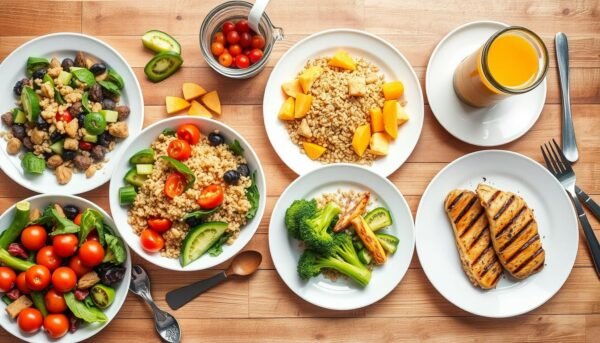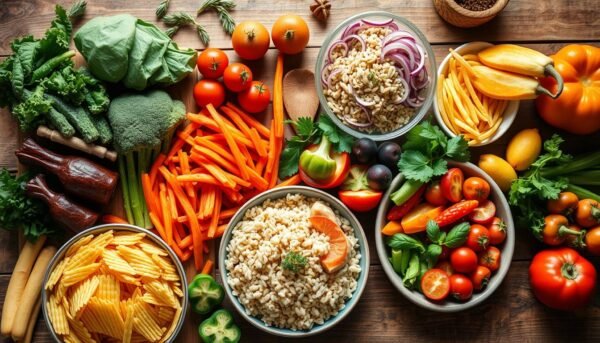Are you tired of fad diets and unsustainable weight loss plans? Lasting weight loss isn’t just about cutting calories. It’s about eating nutrient-rich foods and living a balanced life. But where do you start?
In this guide, I’ll share a tasty and effective weight loss meal plan. It helps you lose weight while giving your body the nutrients it needs. This plan uses a calorie deficit, portion control, and healthy ingredients to support your journey.
Understanding the Fundamentals of a Weight Loss Meal Plan
There’s no single meal plan for everyone. But, eating lots of whole foods and less processed stuff is a good start. You should plan meals that fit your needs, like your weight loss goals and how active you are.
Customizing Your Weight Loss Meal Plan
To make a good meal plan for losing weight, know about portion control, calorie deficit, and balanced nutrition. Here are some tips to help you:
- Try to eat 500-1000 calories less each day to lose weight slowly and safely.
- Eat foods that are full of nutrients, like veggies, fruits, whole grains, lean proteins, and healthy fats.
- Plan your meals and snacks with the right portion sizes for you and your weight loss goals.
- Do at least 30 minutes of exercise every day to help with weight loss and health.
A good weight loss meal plan is made just for you. It considers your unique needs and likes. By understanding the basics, you can make a plan that works for you.
loss weight meal plan healthy eating
Healthy eating for weight loss is simple. This section offers a meal plan that fits your needs and goals. It includes foods rich in nutrients to help you lose weight without missing out on important vitamins and fiber.
A Flexible Meal Plan for Weight Loss
This meal plan is a good start. You can change the portions and ingredients to match your taste and needs. The goal is to eat a balanced diet with lean proteins, complex carbs, and healthy fats.
- Day 1: Dinner includes 4 ounces broiled flounder or sole, 2 sliced plum tomatoes, 1 cup cooked couscous, and 1 cup steamed broccoli.
- Day 2: Lunch involves 1 cup vegetable soup, 1 veggie burger, and 1 cup of fresh grapes.
- Day 3: Dinner consists of 4 ounces steamed shrimp, 1 baked potato with 3 tablespoons salsa and 1 tablespoon unsweetened Greek yogurt, and 3 cups steamed spinach.
- Day 4: Lunch includes 1 cup of tomato soup and a sandwich made with 1 mini whole-wheat pita, 3 ounces thinly sliced roast beef, horseradish, mustard, tomato slices, lettuce, and 2 cups raw veggies with 1/4 cup hummus.
- Day 5: Lunch involves making a quesadilla with 1/4 cup fat-free refried beans, 1 ounce shredded part-skim cheese, and serving it with cucumber spears and 1/2 cup 2% cottage cheese or Greek yogurt topped with 2 clementines.
- Day 6: Dinner entails making jambalaya with 3/4 cup cooked brown rice, 1/2 cup corn, 2 ounces cooked sliced turkey sausage, 1/3 cup salsa, and 1/4 cup no-salt-added black or navy beans, served with 3 cups spinach sautéed with garlic in 1 tablespoon olive oil.
This is just a sample plan. You can change it to fit your life and taste. Focus on eating foods that are full of nutrients, control your portions, and keep a balanced calorie deficit for weight loss.

Grocery Shopping for Weight Loss Success
Starting a weight-loss journey often begins at the grocery store. Plan ahead and make a grocery list based on your meal plan. This helps you buy and eat the right foods for losing weight.
Navigating the Aisles for Weight Loss
When shopping for weight loss, fill your cart with whole foods. Look for fresh fruits and veggies, whole grains, lean proteins, and healthy fats. Stay away from processed and sugary foods, as they can harm your weight-loss goals.
- Prioritize fresh produce, aiming for at least 5 servings of fruits and vegetables per day for optimal health.
- Choose whole grains, such as brown rice, quinoa, and whole-wheat bread, which are high in fiber and can help keep you feeling full.
- Opt for lean protein sources like chicken, fish, beans, and lentils to support muscle development and metabolism.
- Include healthy fats from avocados, nuts, and olive oil to help you feel satisfied and nourished.
It’s also important to read labels carefully when shopping for weight loss. Look for items with minimal added sugars, sodium, and unhealthy fats.

Plan your meals and make a grocery list before you go. This way, you can make choices that help you reach your weight-loss goals. Spending time on thoughtful grocery shopping can help you succeed in your healthy eating and weight-loss journey.
Adapting the Meal Plan for Specific Diets
Weight loss plans can’t be the same for everyone. Our diets and likes change a lot. A good weight loss meal plan must fit each person’s needs.
Whether you’re into vegetarian, vegan, diabetes-friendly, or heart-healthy eating, you can adjust the plan. This makes healthy eating easier and more fun.
Vegetarian and Vegan Diets
Vegetarians and vegans can easily change the meal plan to skip animal products. Eat lots of plant-based proteins like legumes, nuts, seeds, and soy. Make sure you get enough iron, calcium, and vitamin B12 through food or supplements.
Diabetes-Friendly Diets
Diabetes diets need to keep blood sugar levels right. Choose foods with a low glycemic index and lots of fiber. Watch your portion sizes too. Talk to your doctor or dietitian to make sure your plan is right for you.
Heart-Healthy Diets
Heart-healthy diets focus on foods that are good for your heart. Eat lean proteins, healthy fats like avocado and olive oil, and whole grains. Cut down on bad fats, sodium, and sugars to keep your heart strong.
No matter your diet or health goals, making a personalized meal plan is key. Work with your doctor or dietitian to create a plan that’s right for you. With a bit of creativity, you can enjoy tasty meals that are good for you.

Strategies for Sustainable Weight Loss
To lose weight in a way that lasts, find a balance that doesn’t make you feel bad. Cutting 250-500 calories a day is a good start. This slow pace helps you lose 1-2 pounds a week, which is easier to keep off.
Choosing the right foods is key, but so is staying active. Try to do at least 150 minutes of moderate exercise weekly. Break it down into 10-minute bits to fit your day better. A healthy diet and regular exercise will help you reach your goals.
For lasting weight loss, make small, steady changes. Don’t try extreme diets or quick fixes. Focus on building habits that you can keep up with. With time and effort, you can meet your healthy eating goals.
This post may contain affiliate links which means I may receive a commission for purchases made through links. I will only recommend products that I have personally used! Learn more on my Private Policy page.